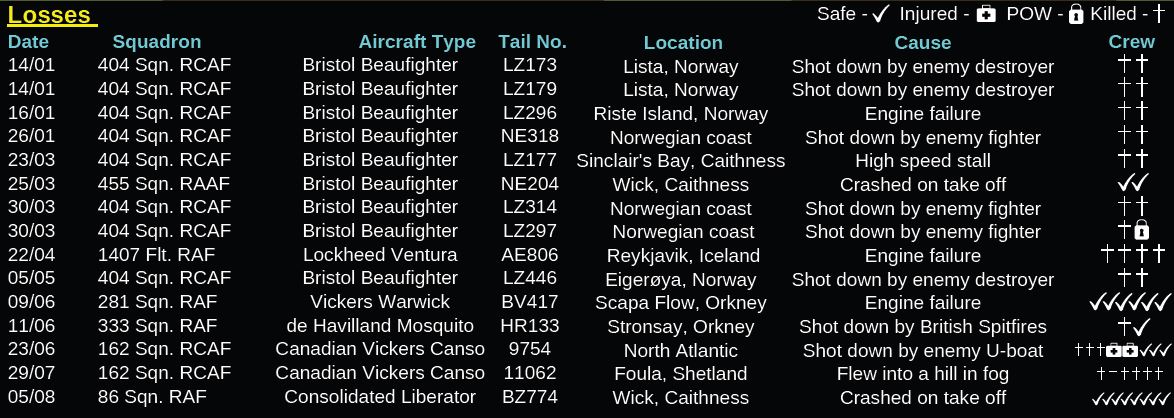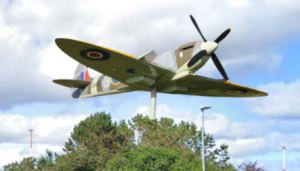Site 28. RAF Wick : January – December 1944
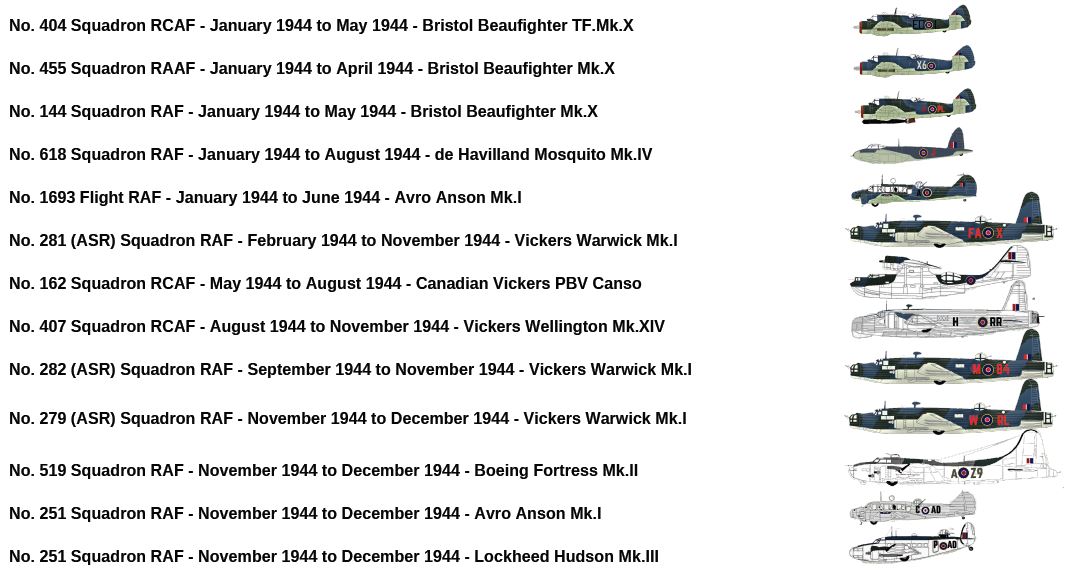
Air Operations – January to December
JANUARY – The Wick Strike Wing flew a total of 129 sorties this month, and a cannon-firing Beaufighter of 144 Squadron attacked a merchant vessel on the 13th, scoring hits along its length with 20mm shells. The following day saw the largest attack to date by the Wing when ten rocket-firing Beaufighters of 404 Squadron along with seven cannon-firing Beaufighters and six Torbeaus of 144 Squadron attacked a convoy of seven ships. During this attack, they scored projectile hits on all vessels as well as torpedo strikes on three. Another raid on the 20th by a mix of eleven Beaufighters attacked a convoy of five ships, scoring hits by 20mm cannon on all vessels, and at least 30 rockets hit the largest ship. The last attack of the month came on the 26th when the same mix of Beaufighters attacked another convoy scoring hits with rockets and cannons.
FEBRUARY – This month saw the arrival of 281 ASR (Air Sea Rescue) Squadron equipped with Vickers Warwicks. The Mosquitoes of the top secret 618 Squadron that had transferred from RAF Skitten in November 1943, continued to carry out special operations in the development of the Highball bouncing bomb. The Wick Strike Wing flew 164 sorties this month in search of Axis convoys to attack. The very first day of the month saw an attack by nine rocket-firing Beaufighters of 404 Squadron and five cannon-firing of 144 Squadron against a convoy of five ships scoring hits on all vessels. No other targets were found during the Wing’s patrols throughout the remainder of the month.
MARCH – A total of 174 sorties were flown this month by the Wick Strike Wing, but only two convoys were spotted and attacked. The first attack came on the 23rd when a mix of rocket, cannon and torpedo firing Beaufighters sighted a convoy of five enemy ships. No torpedo strikes were recorded but every ship was hit and damaged by numerous rockets and 20mmcannon shells. The second attack came on the 30th when a mix of 18 Beaufighters attacked four naval vessels scoring hits on all vessels with rockets and cannons and two hits with torpedoes on the largest ship. A formation of 12 enemy fighters consisting of Focke-Wulf Fw 190’s, Messerschmitt Bf 109s and Bf 110’s, and Arado Ar 196’s engaged the attack force, with two Beaufighters being shot down.
APRIL – The only attack carried out this month was on the 7th, despite the Beaufighters at Wick flying 159 sorties. The attack was against a convoy of three merchant ships escorted by six armed vessels. Eight rocket-firing Beaufighters of 404 Squadron along with two cannon and four torpedo-firing aircraft from 144 Squadron unleashed an assault against the convoy scoring torpedo and rocket strikes against the merchant ships, and rocket and cannon fire hitting four of the escort vessels.
MAY – Only 30 sorties were flown by the Wick Strike Wing before they departed on the 19th for RAF Davidstow Moor in Cornwall. On the 5th and 6th, Torbeaus of 144 Squadron attacked two Axis convoys scoring direct hits with torpedoes. A Beaufighter of 404 Squadron fired six rockets at a merchant vessel anchored off Eigerøya. The strike wing was replaced this month by 162 Squadron flying Canadian Catalina seaplanes, known as Cansos, to patrol in the North Atlantic for U-boats.
JUNE – With the invasion of France launched on the 6th, known as D-Day, RAF Wick concentrated on ASR missions by 281 Squadron, and anti-submarine patrols by the Cansos of 162 Squadron. On the 24th a Canso attacked and sank the German submarine U-1225 with depth charges, but not before being severely damaged during the attack. The events of this day are a tragic story of skill, survival and sacrifice which would see the aircraft’s commander, Flight Lieutenant David Hornell awarded the Victoria Cross, Britain’s highest award for valour. Please see the panel below to learn more about this extraordinary event.
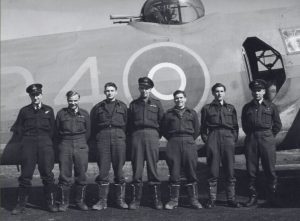
JULY – The Mosquitoes of 618 Squadron continued their special top-secret training on Highball, and 162 Squadron’s Cansos continued their patrols for U-boats over the North Atlantic. Warwicks of 281 Squadron flew four ASR missions this month with a search being launched on the 1st for a Canso that was damaged by fire from a U-boat. Another search was carried out on the14th for a downed Vought Corsair, and the following day two missions were flown to find a ditched Consolidated Liberator.
AUGUST – This month saw the departure of the Canso squadron for Iceland, and the Mosquitoes of 618 Squadron for RAF Beccles in Suffolk. Vickers Wellingtons of 407 Squadron arrived on the 23rd to replace 162 Squadron’s flying boats. The Squadron carried out 20 anti-submarine patrols over the North Atlantic by the end of the month. Warwicks of 281 Squadron flew two search missions for a crashed Liberator on the 18th and a further two for a downed Whitley on the 28th.
SEPTEMBER – Another detachment of Warwicks arrived this month from 282 ASR Squadron to back up the detachment from 281 Squadron that had been at Wick since February. ASR patrols were flown by both squadrons as required to search for downed RAF and FAA aircraft and crews from bases across the north of Scotland. The Wellingtons of 407 Squadron flew 109 anti-submarine patrols using ASV (Air-to-Surface Vessel) radar and Leigh Lights, but no U-boats were located.
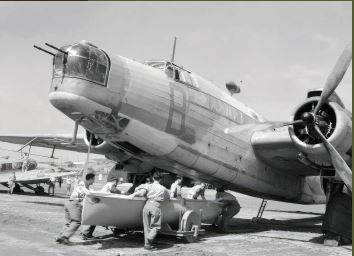

OCTOBER – ASR patrols continued, and 407 Squadron carried out 88 anti-submarine sorties. Radar contacts were picked upon the 2nd, 4th and 29th with U-boats caught on the surface in the beam of the Leigh Light which was a high-powered searchlight. On all three occasions attacks were made with machine guns and depth charges, with two U-boats possibly sunk.
NOVEMBER – The two ASR squadrons were replaced this month by Warwicks from 279 ASR Squadron, and 407 Squadron flew18 anti-submarine sorties before leaving for RAF Chivenor in Devon on the 9th.
DECEMBER – RAF Wick was now primarily an ASR station flying the Warwicks of 279 Squadron but had been joined at the end of November by Boeing Fortresses of 519 Squadron to fly long-range meteorological flights. The once mighty Coastal Command station at Wick was now a shadow of its former self as the war raged on in Europe.
